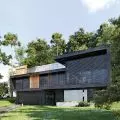Work submitted to the Halina Skibniewskaya student competition - HEALTHY HOUSE
The object of the competition was to design a utopian, environmentally friendly housing development in the spirit of coliving for about 1,000 residents on a three-acre plot located in Cupertino, USA.
The architecture of the estate is composed of repetitive, modular units, variously located
© Alicja Kowalewska, Renata Wacławowicz, Tomasz Węgrzyn
issues
Silicon Valley is a place that concentrates a strongly growing high-tech industry. Unfortunately, the large disparity between the demand for workers and the availability of housing is one of the important factors that makes real estate prices soar. As a result, there is a shortage of housing for people who are not among the highest earners.
Co-living California project, idea
© Alicja Kowalewska, Renata Wacławowicz, Tomasz Węgrzyn
co-living
The premise through its spatial layout supports the circular economy model. Coliving through the idea of sharing goods and resources remains the most ecological form of living. Shared spaces are environmentally and resident-friendly due to spatial and material savings. In addition to being more affordable, this model of habitation makes it easier to make friends. Coliving can be a good option for, among others, people consciously seeking interpersonal contacts, who care about building ties and communities sharing similar values. These may include seniors or artists living collectively. Coliving is also attractive to people who change their place of residence frequently, for whom ease of finding their way in a new city is important. These include, for example, digital nomads who can do their work remotely, from anywhere on Earth, as well as people who are forced to move for their jobs.
Co-living California project, situation
© Alicja Kowalewska, Renata Wacławowicz, Tomasz Węgrzyn
urban scale solutions
The presented concept was based on the idea of a benevolent city. The issue of the scale of the proposed objects was treated with special attention, thanks to which the high density, instead of overwhelming, turned into an asset. The cubic volumes of the buildings became a tissue shaping outdoor spaces, delineating urban interiors and framing views. In this way, a polycentric layout was created, focusing services and individual groups of residents around five squares. Connecting them is a path spilling out to the sides like a river, a path of intense color, which is also the main public space. The path includes recreational, exhibition and sports spaces, and the whole is complemented by greenery tightly filling the spaces in between. The architecture of the estate consists of repetitive, modular units. A feature of the premise is the apparent, but in fact orderly, disorder. Viewed from a bird's eye view, the urban planning of the new housing development resembles a kind of pattern, an expressive pattern similar to those that characterize nearby residential neighborhoods.
floor plans of all floors of the residential model
© Alicja Kowalewska, Renata Wacławowicz, Tomasz Węgrzyn
architectural scale solutions
In designing the apartments in the spirit of coliving, an extremely important aspect was the introduction of a clear hierarchy of privacy and space scale. These are, one by one, the most private rooms, to which only one or two people have access, namely bathrooms and bedrooms. Next are the spaces for eating and preparing meals, dedicated to the residents of the two bedrooms. The next, semi-public vertical common spaces, combine the functions of vertical communication and living room, allowing people to spend time with roommates from across the residential unit. Public squares provide the context for larger events, and the pedestrian avenue connecting them functions as an integrating element for all residents of the development.
Openwork, vertical communal space
© Alicja Kowalewska, Renata Wacławowicz, Tomasz Węgrzyn
materials used, construction and ecology
The simple, conservative architecture was designed with attention to detail and sensitivity to environmental concerns. Due to the warm California climate, the design took into account the issues of ventilation and insulation of the materials used. Cellular polycarbonate and cork, which are the finishing materials, have good insulating properties and reduce heat buildup. The basic construction materials are, in the residential parts, monolithic cross-laminated timber, and in the case of the open-air vertical common space, timber framing. The materials chosen are durable, natural, have a mostly negative carbon footprint and age well. Simple forms, modularity of construction, or optimal use of materials are just some of the green solutions of the coliving estate. The premise also promotes public transportation and bicycles, minimizing car traffic within the estate and offering all the most necessary services within a short walking distance.
Alicja Kowalewska, Renata Wacławowicz, Tomasz Węgrzyn
Illustrations: © Authors














































